

Building a Greenhouse. I grew up living next to my grandparents and spent many days working side by side, starting seeds and transplanting plants, with my grandfather in his greenhouse.

It was a fairly good size with a stone foundation and glass panels. It was attached to his garage which had a furnace to heat the garage and greenhouse and had running water and electricity. I have many fond memories of spending afternoons with my grandfather in his greenhouse. Now that I am older I often dreamt of having my own greenhouse so I could start seedlings in the spring, extend the season in the fall and possibly relive some of those childhood memories.
For several years I looked into purchasing a kit but was discouraged by the high prices and cheap plastic panels they came with so I decided to do some research and design and build my own. Three years ago, after spending countless hours deciding what size to build, what materials to use and what accessories to add, I finally built my greenhouse. Inbox/In-Tray Assessment - Team Management Training from MindTools. Uncovering How an Employee Will Perform on the Job Find out how candidates would deal with the work they'd be doing. © iStockphoto/VallarieE You've got a job opening... again.
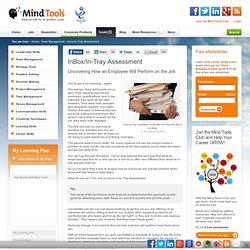
The last two hires didn't work out so well. Their resumes had all the necessary qualifications; and in the interview they gave all the right answers. The first one had no clue how to prioritize her activities and she ran around like a chicken with its head cut off, trying to meet deadlines and failing miserably. The second wasn't much better. You can't go through this again. So you've got to find a way to assess how an employee will actually perform when faced with the reality of daily tasks. What do you do? Tip: The name of this technique could lead you to believe that this approach is only good for selecting junior staff.
Candidates can tell you just about anything to get the job you are offering. Seriously though, if you want to find out how a person will perform, have them show you. Examples might include: Note:
Rubrics for Evaluating Educational Apps. How do you choose the best educational app for your classroom?
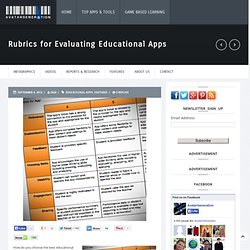
Check out this great post from Tony Vincent on LearningHand, sharing his own rubric to help teachers evaluate educational apps and other rubric resources. Spotlighted in the Rubric are: RelevanceThe app’s focus has a strong connection to the purpose for the app and appropriate for the studentCustomizationApp offers complete flexibility to alter content and settings to meet student needsFeedbackStudent is provided specific feedbackThinking SkillsApp encourages the use of higher order thinking skills including creating, evaluating, and analyzingEngagementStudent is highly motivated to use the appSharingSpecific performance summary or student product is saved in app and can be exported to the teacher or for an audience Download Resources: apps, Rubric. Fair Isn’t Equal: Seven Classroom Tips. In last month's post, I mentioned that there are two skills that separate great teachers from good ones.
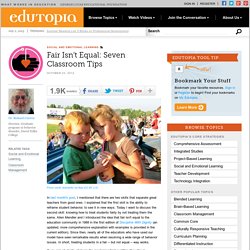
I explained that the first skill is the ability to reframe student behavior, to see it in new ways. Today I want to discuss the second skill: knowing how to treat students fairly by not treating them the same. Allen Mendler and I introduced the idea that fair isn't equal to the education community in 1988 in the first edition of Discipline With Dignity (an updated, more comprehensive explanation with examples is provided in the current edition).
Since then, nearly all of the educators who have used our model have seen remarkable results when resolving a wide range of behavior issues. Google Apps for Administrators: An Introduction. Emotional Intelligence - Assessments - Clarion Enterprises. We offer two assessments for emotional intelligence: EQ-i 2.0 (Emotional Quotient Inventory) The EQ-i 2.0 is the next generation of the globally renowned EQ-i ® assessment.
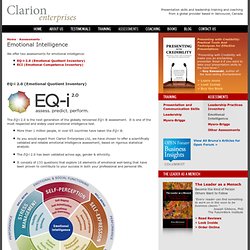
It is one of the most respected and widely used emotional intelligence test. More than 1 million people, in over 65 countries have taken the EQ-i ®. As you would expect from Clarion Enterprises Ltd., we have chosen to offer a scientifically validated and reliable emotional intelligence assessment, based on rigorous statistical analysis. Self-Perception Self-Regard - Respecting oneself while understanding and accepting one's strenghts and weaknesses. Self-Actualization - Persistently trying to improve oneself and engage in the pursuit of personally relevant and meaningful objectives that lead to a rich and enjoyable life. Emotional Self-Awareness - Recognizing and understanding one's emotions. Stress Management Optimism - Remaining hopeful and resilient, despite occasional setbacks.
Teachers iPad Apps. Emotional Intelligence theories - Daniel Goleman's EQ concepts. This webpage is a new format for mobile/small screens.
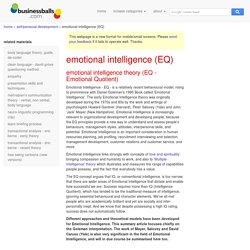
Please send your feedback if it fails to operate well. Thanks. emotional intelligence theory (EQ - Emotional Quotient) Emotional Intelligence - EQ - is a relatively recent behavioural model, rising to prominence with Daniel Goleman's 1995 Book called 'Emotional Intelligence'. The early Emotional Intelligence theory was originally developed during the 1970s and 80s by the work and writings of psychologists Howard Gardner (Harvard), Peter Salovey (Yale) and John 'Jack' Mayer (New Hampshire).